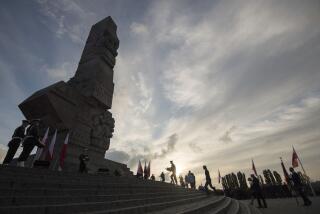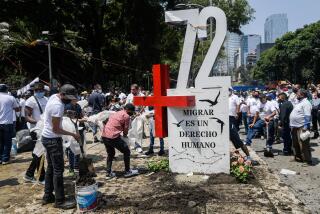Choosing Vengeance or Conciliation
GUATEMALA CITY â In the downtown offices of Guatemalaâs Forensic Anthropology Foundation, its founder and president, Fernando Moscoso, and his photographer, Marlon Garcia, examine the freshly unearthed remains of two children, whose shattered skulls had been lovingly wrapped in cloth before burial.
Far from looking aghast at the tiny skeletons, Moscoso and Garcia are excited by what is in the congealed brain matter inside the skulls--bullet casings, whose caliber matches ammunition used by the Guatemalan army.
âThese children were killed by army-issued Galil automatic rifles of Israeli manufacture,â explains Moscoso, a veteran of the Guatemalan team who was trained in 1992 by Oklahoman Clyde Snow, the globe-trotting dean of forensic specialists.
The foundation--and its politicized agenda--is part of the contradictory legacy of the 37-year war, which left at least 150,000 Guatemalans dead or disappeared and a million more displaced from their homes. On the other side of the coin are the church-related human rights groups whose priorities are conciliation and healing.
Since the U.N.-sponsored peace accords were signed last December, an independent âTruth Commissionâ--known officially as the Historical Clarification Commission, coordinated by former U.N. special envoy Christian Tomuschat, is enlisting the foundationâs forensic specialists to gather evidence of mass killings by both the military and the four leftist guerrilla organizations of the Guatemalan National Revolutionary Union (URNG).
Next week, Sen. Christopher J. Dodd (D-Conn.) plans to call for the U.S. government to declassify CIA documents on Guatemala and make them available to the commission.
The diggings begin on Sept. 8 and Snow will return in October to help in the forensic analysis of a mass grave in the northeastern town of Panzos, where the first massacre of Maya campesinos by the army took place in May 1978.
The shooting broke out after hundreds of landless farmers invaded private land-holdings, and massed in the town plaza to demand the return of their ancestral lands. With the collusion of the landowners, army soldiers opened fire on the peaceful protesters with machine guns and automatic rifles, killing an estimated 100 to 150 campesinos. Most of the bodies were bulldozed into a large pit the army had excavated beforehand.
Moscoso explains that each bone has a story to tell about the victims as well as their executioners: âHands tied behind the back, evidence of torture, hand-grenade fragments, large numbers of women and children, all these can point to an army-style mass killing. Even a skeletonâs angle of repose may reveal that it was a planned execution.â
In the central highland zone of Rabinal, for example, the bodies of 80 women and 100 children found shot and stuffed down a well weighted the evidence overwhelmingly against the army, which accounts for 90% of the massacres uncovered so far. In sites where guerrillas did the killings, executions of army informers with a single bullet to the base of the neck was a typical modus operandi.
Besides the 11 young Guatemalan anthropologists and archeologists of the Forensic Anthropology Foundation, a church-related group, is also actively gathering evidence of civil war atrocities. This group, the Project for the Recuperation of Historical Memory, originated in the human-rights office of Guatemala Cityâs Catholic diocese. It has seven forensic specialists and, in addition, has amassed 5,500 eyewitness testimonies in 547 massacres and thousands of other human-rights violations, most of which have been traced to the military.
The office is completing an analysis of the political, economic and social findings of their study, to be published next year. The project director, Ronalth Ochaeta, underscores that, unlike the Truth Commission project, whose mandate prevents it from naming the violators, the project will publish hundreds of names of âmaterial authorsâ of crimes against civilians.
And unlike the more political Forensic Anthropology Foundation, the church groupâs mission is to repair the torn fabric of Guatemalan society by working for reconciliation within their communities as well as to document evidence of atrocities for the historical record.
The project will culminate with a memorial to the war victims to be raised in the atrium and the steps of the cathedral.
The thousands of survivors interviewed by the church project want the killers exposed and expelled from their communities, Ochaeta said, but most do not favor prosecution that will perpetuate the cycle of revenge killings.
In fact, many of the survivors in the countryside reveal a surprising lack of vindictiveness. Above all, they want their dead identified and given proper burial. And, sensitized by the war to world opinion about Guatemalaâs Mayas, they want it known that they consider neither the victims nor their executioners and torturers to be âanimals,â but are instead human beings with parents and children, just as they are.
The Forensic Anthropology Foundation, which is scheduled to investigate the mass murder in Panzos for the Truth Commission, is driven by its own sense of outrage at the armyâs lawlessness. These forensic anthropologists are resolved to bring down the militaryâs centuries-old wall of impunity from prosecution. They expect to find proof of human rights violations that will force the government to take action.
There is a precedent for this expectation. Last year, the head of a civil-defense patrol unit trained by the army was tried and sentenced to 28 years in jail for murder, based on forensic evidence gathered by the foundation.
Panzos, where the digging will begin next week, has become a safe haven of guerrilla supporters. URNG slogans cover the walls of the municipality. âThe URNG does not collect war-taxes,â reads a questionable scrawl outside the mayorâs office. âIt solicits voluntary contributions.â
As the exhumations get under way in Panzos, Moscoso and his staff are carrying out 150 interviews with survivors and relatives of the dead. Whatever the final count may be, he expects to find only about 80 bodies in varying stages of decomposition. Many victims, Moscoso said, drowned in the river during flight or were taken out of the hospital by the army and never heard from again.
Although the chances of finding forensic evidence against the military officers who ordered the killings are remote, they do expect to find large bones with bullet punctures and other trauma that may point to the army units who carried out the killings. When they are done, they will turn over the evidence to the governmentâs Interior Ministry, which issues criminal indictments.
As in previous digs, Panzos townspeople will take part in the excavations, and look for toys and other keepsakes, as well as items of clothing that might help identify their dead.
Before the exhumation begins, as an established custom, a ritual service will be enacted in the town church to purify the gravediggers and ask forgiveness of the victims for desecrating their graves.
Moscoso said that, during preliminary interviews, he was surrounded by hundreds of mothers and other relatives who demanded that he carry out the exhumations. âI was alone and did not have the authority to speak for the foundation; but I pledged to them, yes, we will do this, for the survivorsâ sake, and for the sake of justice.â
More to Read
Sign up for Essential California
The most important California stories and recommendations in your inbox every morning.
You may occasionally receive promotional content from the Los Angeles Times.










